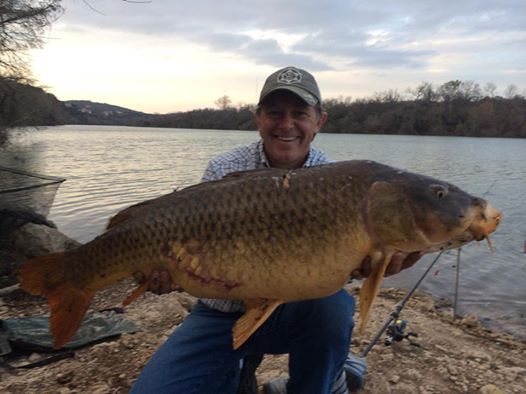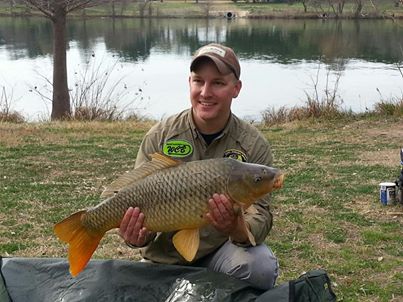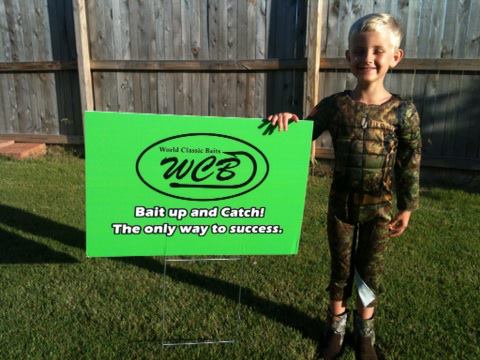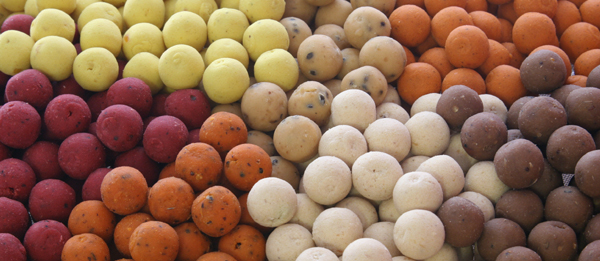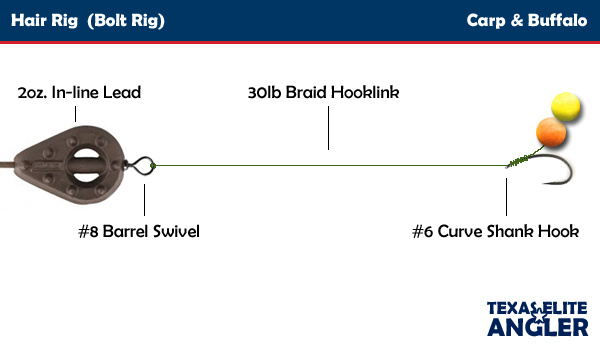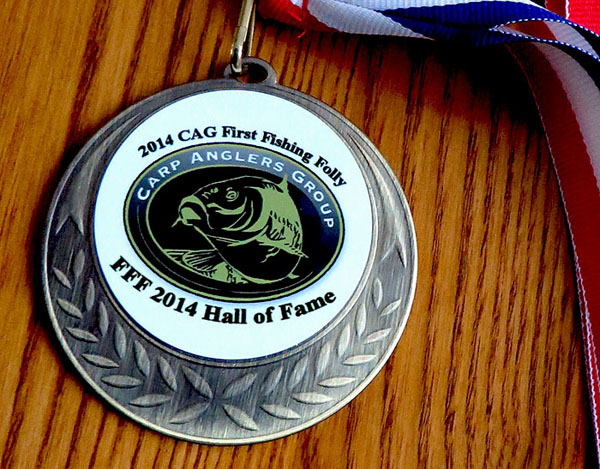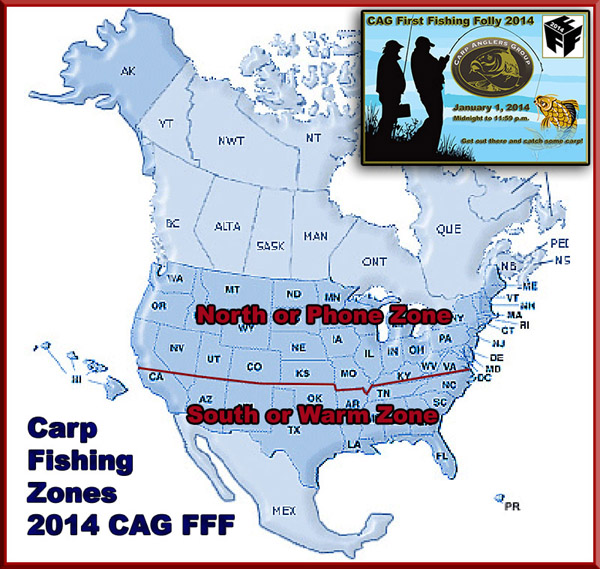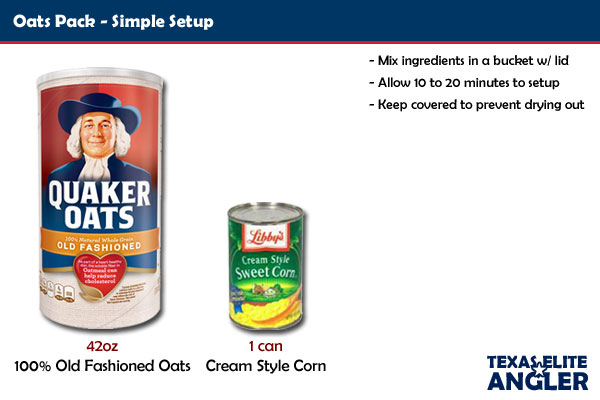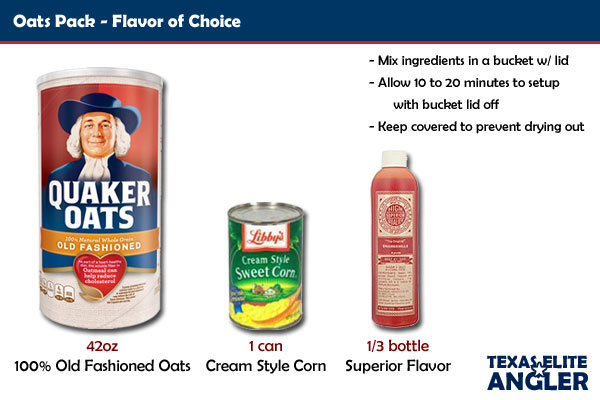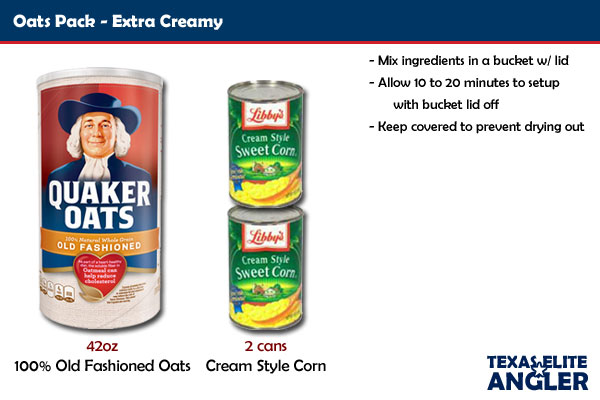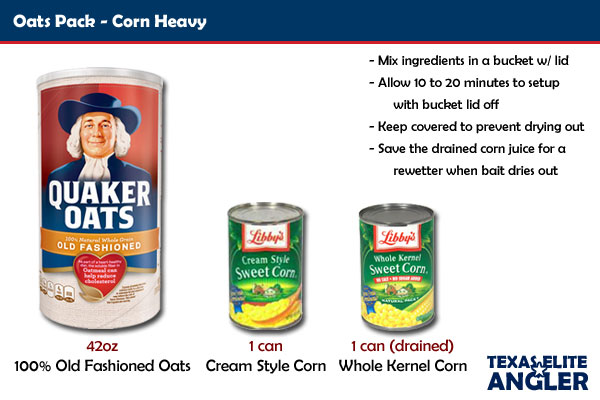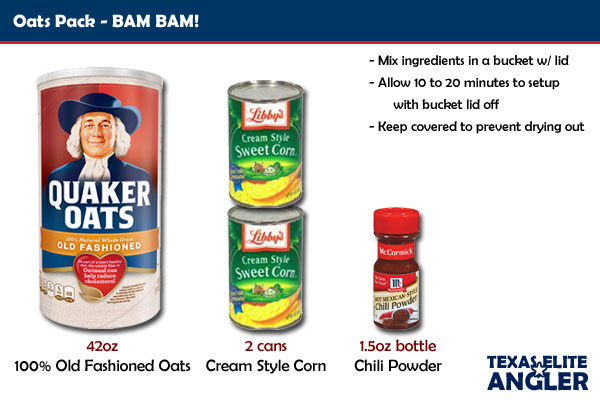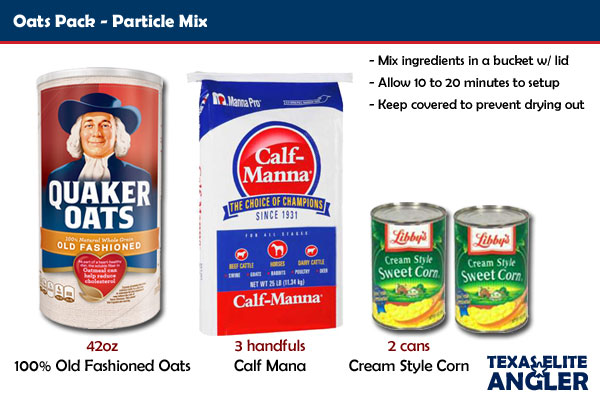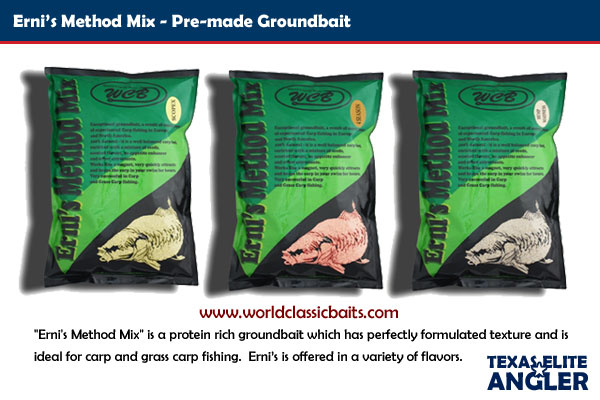Blog Archives
Texas State Record Common Carp Matched at ATC 2014
Every Austin Team Championship angler wishes it was he or she who lands the new state record common carp, but it was Steven Bates of Team Bates Brothers who came as close as you can get without setting the new record. Steven matched the state record ounce-for-ounce with this whopping 43 lbs 12 oz common. It had been a long, uneventful session with no fish caught, but in the final hour as the sun was beginning to set on the day and the tournament this stunning common took the bait. Carp this big are ancient and the body of this old behemoth tells the story.
Well done, Mr. Bates. Much respect.
ATC 2014 – Day 2 – Report From Peg 13
Day 2, crack of dawn, and I’m feeling yesterday’s 12 hours in my bones, but all things considered I feel good. I wake up to the Game of Thrones title theme (It gets me in the competitive mood) and begin mentally preparing for the day. Team 1 needs a darn good peg if we’re going to pull this one out of the fire. I don my fishing shirt and make my way to the conference room where the draw will occur. I’m the first one there. 12 hours of fishing takes it’s toll on the body and the contrast between Day 1 where the room was full when I walked in to Day 2’s empty amphitheater was telling.
Team 1 would be 8th to draw today which meant we had a decent shot at getting one of the coveted pegs. You can imagine my dismay when I pulled #10 and #13 from the bag. #10 was unselected on Day 1 which meant no bait was in the water — not a good prospect. It’s worth noting here that it’s good to pay attention to such things so you don’t find yourself at a fresh peg that hadn’t been pre-baited from the day before. No one wants that disadvantage on Day 2. #13, the number alone made me shiver, but the peg did see fish on Day 1 and it was on the north side of the lake. With a south wind in the forecast it was the clear choice despite it’s ominous double meaning. Would #13 be lucky, or unlucky as the number implies. Hotels don’t have a 13th floor. Should ATC have a 13th peg?
Peg selected, my partner and I raced away in the pre-dawn light to our temporary home for the next 12 hours known as “Ball Fields Channel”. Immediately we had concerns during our peg walkthrough. There were two open areas to place a pod, but one had a heavy canopy over it that would not accommodate 13 or even 12 foot rods. My partner tried casting from a seated and kneeling position but after one hang-up in the canopy and a few choice words we abandoned the spot and squeezed in to the available open space. A check of the lake topography on Navionics showed a deep troth but not much in the way of features or structure.
We set left and right limits, baited up and set out our lines. The timer started and we were skeptically hopeful.
BBBEEEEEEPP!! My right rod took off and I broke into a dead sprint like a coyote was chasing me. I loaded up the rod and played her in. After a short fight we wet the mat with a 15-pound common. It was a modest start, but it counted. I baited up a little more to entice the shoal of commons to stick around a while longer. We waited for the next run that never came.
In the following 10 hours of fishless waiting, you learn a lot about yourself as an angler. Your self-confidence is tested as the doubt creeps in. What am I doing wrong? Why aren’t my rigs working? Is my bait not attractive? and so on… You try everything you know how to do, and a few things you’d never do just to try to get the fish to bite. Some anglers get angry, some depressed and others give up, but it’s the challenge that makes the ATC so interesting. It’s the definition of “Angling”. You are presented with a challenge or condition that you don’t know how to deal with and you work through it to catch fish. You learn from it and ultimately come through the other side a better angler if you allow yourself the growth. My best advise if you find yourself staring down a blank session is do what you know, make fine adjustments and stay focused. Angling is based on subtleties of a pattern. If you’re not focused you’ll miss the learning opportunity and that’s much worse than simply not catching fish.
As the sun set on Lady Bird the tournament came to a close and Team 1 had failed in it’s mission to bring the trophy home, but were victorious in pulling fish out of two very difficult pegs. At the end of the day I had fish slime on my shirt, a wet unhooking mat and a smile on my face.
ATC 2014 – Day 1 – Report From Peg 8
At 5:30am I was faced with a tough decision that would ultimately decide my placement in the ATC standings on Day 1. The phrase, “the better of two evils” comes to mind. Being slotted as the 18th draw out of 25 teams meant that chances were good that many of the good pegs would be taken by the time my turn came. As team after team went up and drew their pegs I was noting each one and could see that a few of my top picks were claimed — but not all them. My time did come, and I was presented with two options of which neither were high on my prioritized list of pegs. You see, the night before I considered the weather conditions, lake typography and intelligence gathered at the social event to generate a ranked list of which pegs I felt would produce and those that would not. Given only 10 seconds to make your decision at the peg draw, I wanted a list that would help me make the decision…smart?…maybe. Neither peg ranked higher than the midpoint of favorable pegs, but I stuck to the strategy and picked the highest, Peg 8.
Peg 8 known as Pleasant Valley, was quite pleasant. It was located on the south side of the lake which wasn’t ideal in my book as we were to receive wind out of the south and you always want to fish into the wind (See how wind affects fishing). It was also a tight squeeze for two pods. The condition pushes one team angler to fish the cove which at 6:30am before sunrise didn’t look like a good prospect. A plus for the peg was that it was outfitted with a nice park bench at the water’s edge as well a substantial picnic table to hold bait and bits. It had a trash can, bonus; but no access to a bathroom. Did I mention we were fishing for 12 hours?
Navionics showed the lake bottom to be very deep, even in the cove. 28 to 29 feet in most places. The wind had been blowing pretty hard out of the north the day before and a few days prior so I was hopeful enough food items had collect here that the fish would still be in the area. In fact, as we were setting up, we witnessed a heavy roll at the mouth of the cove.
I felt confident that if we could get in the water quickly at 7am we could pull out a fish before they moved off to shallower water when the sun came out and started warming up the shallows.
We were ready and cast our first lines at the stroke of 7am.
After enough time for the commons to locate and begin feeding on our pack bait I got a vicious run. I was standing next to my rods when it screamed off so I loaded up and could feel it was a good fish. My pod was located on the right side of the park bench where you see ACA member, August Wells, sabotaging my gear while I have my back turned (Kidding…I think).
You also see that tree canopy. What you don’t see is a gnarl of roots and a gigantic floating log that made playing the fish in a bit of a challenge. This 20.04 common was a real wise guy, darting back and forth across the swim, collecting one of my lines and tried to get in my team mate’s line before I turned his nose back. He stayed on the bottom all the way to the bank, a real scrapper.
At the time this was one of three fish caught across the tournament and I was feeling better about the swim choice, but still knew in the pit of my stomach that we had our work cut out for us. The rest of the day played out in slow motion. A couple knocks on the line but no runs for either me or my partner. Our next door neighbor, August and his super-cool wife, had a similar fate. One good fish and then siesta time for the remainder of the day.
We each watched in disgust as the the famous Peg 9 – Gazebo swim across from us hauled all day. There was much consideration between Pegs 8 and 7 if we could launch a lead that far.
With Day 1 in the books, Team 1 has a lot of work to do on Day 2 if we want to get into the Top 3 — my goal. Day 1 is tactically a day of constraint. What I mean by that is you don’t want to put a lot of bait in the water on Day 1 else you’ll pre-bait the swim for the next team. Day 2 is a different story. The gloves come off.
Tomorrow is a new day and a new opportunity to land big fish and hopefully a new PB (30+ please).
Special thanks to CAG for hosting a great event and World Classic Baits for the ammunition to put a fish on the bank where other pegs were not so lucky (including the peg I didn’t choose…phew!).
Tomorrow….we’re baiting up.
Wish Me Luck – ATC 2014
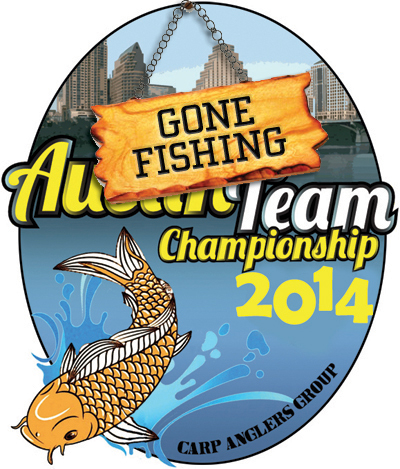 I am in full preparation mode and will not be around for a few days while I fish my heart out at the Austin Team Championship. You can expect a full write up when I return. Good luck to all my fellow anglers.
I am in full preparation mode and will not be around for a few days while I fish my heart out at the Austin Team Championship. You can expect a full write up when I return. Good luck to all my fellow anglers.
Competing Teams at this year’s Austin Team Championship:
1) SOUTHERN CARP EXPERIENCE
Joe Carter & Clayton Lothrop (Texas – YEAH!)
2) MICHIGAN CARPERS
Nikolas Williams & Drew Nichols (Michigan)
3) TEAM TIGHT LINES
Brian Daugherty & Tom Daugherty (Michigan)
4.) ACA4LIFE
Keith Thompson & Kevin Oliver (Texas)
5) THE YOUNG GUNS
Austin Pass & Brendan Pass (Michigan)
6) BIG CARP U.S.A.
David Moore (Oklahoma) & Brian Nordberg (Texas)
7) TEAM BOSSARD
Melissa Mc Daniels & Kurt Bond (Texas)
8) Team SONIQ
Wayne Boon & Richard Cervantes (California)
9) Team STOUT/ K1 BAITS
Tony & Christine Stout (Indiana)
10) Team –TIPPED SCALES
Carl Norris (Texas) & Evan Cartabiano (Oklahoma)
11) Team–VCARPERS
Son Ho & Michael Tran (Texas)
12) Team—NTX CARP PRO
Jon Eisen & Joseph Raguro (Texas)
13) Team—Norgge
Christopher & Sydney Norris (Texas)
14)— Team —THE WOOLARDS-ACA
Lyndsey & Chad Woolard (Texas)
15) Team — K-1 Baits & Polonia Carp Team
Marcin Szydlowski & Henryk Burza (Poland)
16) Team— CARP-E- Diem
August & Ashleigh Wells (Texas)
17) Team — POLONIA CARP TEAM
Daniel Szorc & Andrzej Burnagiel (Poland)
18) Team — DALLAS HOOKERS
Chris Harrington & Jesse Chavez (Texas)
19) Team — BATES BROTHERS
Michael & Steven Bates (Texas)
20) Team —GOLDEN BALLS
Mark Metzger (Maryland) & Phil Saunders (Virgina)
21) Team—TBA
Christian Torres & Chad Edwards (Texas)
22) Team — PEG LEG
Chris Vines & Mark Villanova (Texas)
23) Team —HOOSEIRISH
Brid Caveney & Kenny Keaton (Texas)
24) Team— RICKYRICK
Ricky Wilson & Rick Wilson (Texas)
25) Team ——NO CHANCE
Frank Kessler & Andy Longstreth (Texas)
What Bait Do You Use To Catch Carp :: Boilies
If maize isn’t doing the job, or I’m fishing waters that boilies work well on I switch my baits over these popular carp baits used by most anglers. I always keep a well stocked arsenal of flavors and sizes of boilies at the ready and I’ll often mix and match boilies and maize for a fresh, colorful presentation.
What are Boilies?
Boilies are essentially a dough bait that has egg added as a binder and boiled to create a skin on the bait, thus “Boilie.” Corn meal, Semolina and Soy Flour are a common base material. From there the additive combinations are endless depending on what you’re after in regards to texture, color and flavor. Boilies are most commonly round baits, but as more and more carp get used to associating a hook with a round boilie, other shapes like dumbbells are used. This is more of a UK problem than in the US where carp simply aren’t pressured enough on most waters to begin making associations.
How do Boilies Work?
Boilies can be used in two different ways, as a hookbait, meaning its attached to your hair rig, or as a free offering. Being a round bait, boilies have an aerodynamic quality that allows them to be deployed accurately to the spot you’ve chosen to bait up. This is accomplished using a throw stick or a catapult (Sling-shot) (See Getting Your Bait Out There). Hookbait boilies are generally the more flavorful bait, with a greater level of attractants and color than your free bait boilies. The strategy here is we want the carp to find your diamond in the rough and gobble it up.
What’s the Difference Between a Bottom Bait and a Pop-up?
There are two types of hookbait boilies, bottom baits and pop-ups. Bottom bait boilies are just that, they rest on the bottom looking yummy and waiting to be eaten. Pop-ups are buoyant baits. They will float when submerged so your rig will have to be designed and weighted to set the height of the pop-up. It’s always a good idea to test the rig in shallow water so you can see what your presentation looks like. Pop-ups can be used in conjunction with bottom baits to balance a bait. Balancing a bait basically allows it to stand up, act more like a free offering and more easily enter a carp’s mouth on a pick-up.
What sizes do Boilies come in?
Boilies come in a range of sizes from very small, micro baits around 6 to 8mm, to honking huge baits at 40mm. Most anglers use 10mm to 20mm baits. I prefer 12mm to 16mm.
Where do I get Boilies?
Similar to maize you have two choices here, buy boilies, or make them yourself. Personally, I prefer to buy them, primarily because the materials needed to make your own boilies properly is a bit extensive. Not counting the food materials, you’ll need to invest in a good sausage gun, drying screen and rolling tables for the size of boilies you want to make. It is definitely a hobby I am looking to explore but I just haven’t made the investment to get started. If you’re looking to just make about 100 boilies you could make due without this equipment by hand-rolling your baits, but if your wanting to make pounds of boilies then you’ll want to get the appropriate equipment for mass production.
You have a few options when buying boilies. You can buy them from U.S. makers, such as World Classic Baits, or buy them from carp specialist retailers which will give you access to a range of boilies from UK companies. Be careful what you’re buying though, old stocks at retailers could get you some boilies that spoil sooner rather than later. Avoid tempting clearance sales where boilies are concerned and you should be ok.
How Long Do Boilies Keep?
This depends on which kind of boilie you get. There are shelf-life boilies, also known as “Shelfies” that have preservatives which allow them to keep unrefrigerated for months. The alternative if freezer baits, or “Fresh Frozen” baits meaning they were made without preservatives and frozen fresh until ready to use. These baits are made without preservatives and will spoil within a few days if unrefrigerated.
So which is best? That’s a good question which will get you a different answer depending on who you ask. For the fish, fresh frozen baits are best. The lack of preservatives is better for the long-term health of the fish that will be eating your free offerings. It’s simply a more pure food item. Convenience must also be considered. Do you have available freezer space? Will your wife mind you storing your baits in the freezer (If mama ain’t happy, nobody’s happy). If you don’t have the space then Shelfies may be the bait for you. These are high-attractant baits that will catch fish, but if you plan to spend a lot of time on a body of water, then I would encourage you to go with fresh frozen baits for the long-term health of the fishery. I’ve heard it said that carp will ignore shelfies because carp can detect that the food item isn’t good for them, but I’ve also heard the opposite that a shelf-life bait has results in fantastic sessions. You’ll have to be your own judge.
How do you Make Your Own Boilies?
coming soon….
What Bait Do You Use To Catch Carp :: Flavored Maize

For many carp and buffalo anglers, including myself, “Maize” is the go to confidence bait. I have been so successful with maize that I hardly give boilies a second look. At least on North Texas waters, maize seems to be the bait of choice. So what is maize and what makes it so special?
What is Maize?
First of all Maize isn’t sweetcorn. Sweetcorn is the soft, food corn we get canned from the grocery store, whereas maize (or field corn) is dry and is primarily used in corn meals and flours. Maize is much sturdier than sweetcorn which is why it’s so popular with fisherman. Sweetcorn can very easily be taken off the hook by nuisance fish or fly off on the cast. Maize is there to stay.
Where do I get Maize?
You can get Maize in two ways, prepared and unprepared. Let’s tackle unprepared first. Ever go to Wal-mart around the start of fall and see the big end-caps of Deer Corn? That’s maize! 40lbs for $9 makes maize an extremely cheap bait. You can also find deer corn (field corn) at Feed Stores sold in 40 to 50 lbs bags. It’s important to note that raw field corn in the bag can not be used for fishing until it is properly prepared. We’ll cover preparation below.
If you don’t want to bother with maize preparation, then you can buy prepared maize. These baits have been properly soaked, boiled for softness and flavored to perfection. They also come in small containers so you don’t have store 40 lbs of corn in your garage (Your wife will thank you). There’s a few options for prepared maize in the U.S., but my favorite is World Classic Baits. You can’t go wrong with “4 Season” maize.
As I said, raw field corn is not fish safe. If you chum out raw, uncooked field corn fish will consume it and the corn will swell in the fish’s belly as it absorbs water. This can cause digestive complications or a burst stomach that will kill the fish.
If you want to make your own maize, and most anglers eventually do so they can try their hand and making a magic bait, then follow the steps below for a fish-safe bait.
- Pour your desired amount of maize into a 5 gallon bucket
- Cover with water such that the water line is 2-inches over your maize. (as maize soaks it will absorb the water and swell, thus the 2-inches of water coverage)
- Let soak for 24 hours (you may check on it after 12 hours to ensure the maize is still covered with water)
- Next, boil the maize for approximately 30 minutes.
- Check softness. You want the maize soft enough to be easily pierced by a baiting needle.
- Drain off and allow to cool (TIP: You can use the drain off in ground bait or to soak other baits)
- Add your desired flavor and soak as maize cools (cooling maize will absorb flavor)
- Containerize and use for fishing or freeze.
What Flavors of Maize Work Best?
In my opinion, in order of effectiveness
- 4 Season (from World Classic Baits)
- Pineapple
- Tutti Frutti
- Scopex
- Strawberry
How Long Does Maize Keep?
Prepared Maize bought from bait retailers is normally around 3 months, but you can extend that time considerably if you refrigerate your baits when not in use. If unrefrigerated, maize will last only a few days before it begins to ferment unless you use a preservative such as Kosher Salt. Of course some anglers believe that fermented maize works better than fresh maize.
How to Make Maize Wife (Landlord) Friendly?
Listen up gentlemen. If you buy 40 and 50 lbs bags of field corn do yourself a big favor and by a seal-able rubber bin, like Tupperware. If you leave a bag of maize in the garage three things will happen:
- You will invite a mouse infestation into your garage
- You will have a boll weevil infestation in your garage
- Your wife will karate punch you in the the throat.
Trust me.
Using Maize with Other Baits:
I’ve also found it effective to top off a bait like sweetcorn, a boilie, or tigernut with a kernel of flavored maize. The hardy kernel will keep everything in place and adds a pop of color and flavor. A killer combo.
Carp Rigs :: Hair Rig (Bolt Rig)
The Hair Rig is the most common rig tied by carp and buffalo anglers since the 1970s when the rig was conceptualized and fielded with great success. As you can see pictured above, you are actually presenting the bait “off the hook.” This approach works well because of two reasons. 1.) You are fishing a fully exposed hook. There’s nothing to get in between the hook point and the flesh of the fish’s mouth. If the hook was loaded with bait, there would be a good chance the carp could eject the hook without getting pricked. 2.) Carp are extremely adept at determining what is and is not a food item. They’re sensory capability is remarkable, and they can easily detect a hook and blow it back out. By presenting the bait off the hook, the carp will pickup the bait, taste nothing but food and then suck the rest of the rig into there mouth where the fully exposed hook will find a hold. Then hang on!
The Bolt Rig is a configuration of a Hair Rig that speaks to how the lead is attached to the rig. In this case, the lead is semi-fixed on the line. When a carp picks up the bait and begins to swim off, the weight of the lead will engage as the slack of the hooklink (usually 6 to 9 inches) plays out. The large 2-ounce lead will put enough resistance on the line to self-set the hook into the fish’s mouth.
It’s a brilliant rig setup that has caught a lot of fish.
Clayton Wins at First Fishing Folly 2014
Time for a little patting myself on the back. I recently participated in the Carp Angler Group’s (CAG) first of year contest known as First Fishing Folly (FFF). The goal behind FFF2014 is to encourage carp anglers to get out after the stroke of midnight to catch their first carp of the year. What a fun idea! The catch is that the 1st of January tends to mighty cold in most parts of the country, including Texas. FFF2014 is a nation-wide contest, so other anglers had much worse conditions than I had to contend with.
Loving the concept I threw my hat into the ring and participated in this creative, well executed contest.
My results:
Lucky 13 – FFF2014 Hall of Fame ($10)
An award that goes to the first 13 anglers to catch a carp in 2014. I came in 7th with my 5lb 7oz prize at 7:55am. Much later than I had planned.
1st Place – Smallest Fish – South Zone ($25)
I’m not particularly proud of this one, but I did also manage to land the smallest fish for the South Zone ringing in at a whopping 2lbs 12oz.
1st Place – Jerome Adventure Tale Award ($25)
This award is for the best written story regarding your FFF2014 experience. Anyone who knows me, knows I love to tell a good story so this award was a special one for me. I am absolutely thrilled I took 1st.
So, $60 and a nice shiny Hall of Fame medal ain’t too shabby for an old Texas boy on a cold New Year’s morning. Honestly, it was a blast. I really enjoyed seeing the pictures and posts from anglers across the country. If you like fishing and the opportunity to participate in fun challenges, then ask me about CAG. I’ll get you hooked up (pun intended),
The Next Fish Is Yours – Austin Carp Anglers
Have you been considering fishing for carp and buffalo but didn’t know quite how to get started? Well here’s your chance to learn from experienced carp anglers in one of the finest carp and buffalo fisheries in the state. Captures in the 30 to 50 lbs range is possible. You don’t need any gear, just a willingness to learn. See the gear in action, see the bait and rigs used, ask your questions to experienced anglers and have a great chance to land big fish. See the details below and checkout ACAs website and facebook page for more detials (links below).
Austin Carp Angler would like to announce “The Next Fish Is Yours” monthly series of events next year!
Starting in January 2014 we would like everyone to come and join us during our weekend fishing outings. Anyone is welcome, whether you are an angler already, have years of experience, or absolutely none. Come and join us at the spot we are fishing and the first bite that happens after you get there will be yours, next run goes to the next person to arrive. You don’t have to bring anything other than your own food and drink and the enthusiasm to catch a carp or buffalo – however if you are already a carp angler and want to join us with your own gear we will try and put you on fish too. There is no cost to attend, no prizes will be given out, you will have your picture taken with the fish you catch and those pictures will be posted on the ACA web page and Facebook page.
Event locations will be published on our Facebook page and the ACA web site at least two month before the actual event date. We do ask that if you are planning on joining us that you RSVP to the Facebook event so we can get a good handle on how many plan on attending.
The dates below are the weekends that we have allocated for these events. Event dates are subject to change based on local conditions – another reason we would like RSVP’s so we can notify you of of any changes and let you know exact locations we are fishing on the various area lakes
We will try to have to have at least one ACA member fishing on Saturday or Sunday (with optional Monday’s).
The full schedule of dates is as follows
– Jan 18-20 – Decker Lake
– Feb 15-16 – Decker Lake. This is the weekend before the ATC so Ladybird is off limits
– Mar 22-24 Ladybird LakeNo competition, no prizes, no entry fees, just plain ole fishin’ with local Austin anglers who know the waters!
Oats Pack Bait Recipes for Carp Fishing
One of the most effective methods of fishing for carp and buffalo is using “Pack Baits”. Pack baits are used as a confidence builder for feeding carp as opposed to just fishing a hook bait. The strategy behind this method is to provide a tight bed of free, or hook-less, bait that carp can feed on confidently until they discover and eat your hook bait, then… FISH ON!
Oats Pack is probably the most widely used pack bait among carp anglers along side grits (coming soon) that produces faithfully all year long. Below are some of the common variations on the simple recipe that will absolutely work to put fish on the bank. Feel free to experiment with your own additives and if you strike gold, please share. Oats and corn are easily found in your local grocery store. Any brand will do — I prefer the cheaper brands such as Walmart’s Great Value brand.
You can also buy method mix (aka groundbait) from carp bait vendors. “Erni’s Method Mix” from World Classic Baits has proved to be massively successful in the United States and has been the winner’s groundbait in many carp tournaments.
